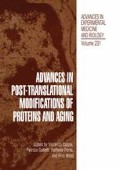Abstract
Protein phosphorylation is an important mechanism of regulation in many metabolic pathways.In muscle glycogen metabolism,the enzymes involved in anabolic steps are activated by a dephosphorylation,the enzymes involved in catabolic steps are activated by a phosphorylation.
Access this chapter
Tax calculation will be finalised at checkout
Purchases are for personal use only
Preview
Unable to display preview. Download preview PDF.
References
Foulkes J.G., Jefferson L.S.,Cohen P. (1980).The hormonal control of glycogen metabolism:dephosphorylation of protein phosphatase inhibitor-1 in vivo in response to insulin. FEBS LETTERS 112–21.
Seals J.R., McDonald J.M., Jarrett L. (1979). Insulin effect on protein phosphorylation of plasma membranes and mitochondria in a subcellular system from rat adipocytes. The Journal of Biological Chemistry. 254–6997.
Cohen P. (1982). The role of protein phosphorylation in neural and hormonal control of cellular activity. Nature 296–613.
Kasuga M.,Karlsson F.A.,Kahn C.R. (1982).Insulin stimulates the phosphorylation of the 95,000 Dalton subunit of its own receptor. Science 215–185.
Perrotti N., Taylor S.I., Richert N.D., Rapp U.R., Pastan I.H., Roth J. (1985).Immunoprecipitation of insulin receptors from cultured human lymphoblats (IM-9 cells) by antibodies to pp60src. Science 226–761.
Ullrich A., Bell G.R.,Chen E.Y.,Herrera R.,Petruzzelli L.M.,Dull T.J.,Gray A.,Coussens L.,Liao Y.C.,Tsubokawa M.,Mason A.,Seeburg P.H., Grunfeld C.,Rosen O.M.,Ramachandran J. (1985).Human insulin receptor and its relationship to the tyrosine kinase family of oncogenes. Nature 313–756.
Downward J., Yarden Y., Mayes E., Scrace G.,Totty N., Stockwell P., Ullrich A., Schlessinger J., Waterfield M.D. (1984) Close similarity of epidermal growth factor receptor and v-Erb B oncogene protein sequences. Nature 307–521.
Simpson I.A., Hedo J.A. (1984). Insulin receptor phosphorylation may not be a prerequisite for acute insulin action. Science 223–1301.
Ellis E.,Clauser E.,Morgan D.O.,Edery M.,Roth R.A.,Rutter W.J. (1986). Replacement of insulin receptors tyrosine residues 1162 and 1163 compromises insulin-stimulated kinase activity and uptake of 2-deoxyglucose. Cell 45–721.
Morgan D.O.,Ho L.,Korn L.J.,Roth R.A. (1986). Insulin action is blocked by a monoclonal antibody that inhibits the insulin receptor kinase. Proceedings of the National Academy of Science U.S.A. 83–328.
Grunberger G., Comi R.J., Taylor S.I., Gorden P. (1984). Tyrosine kinase activity of the insulin receptor of patients with type A Extreme insulin resistance:Sudies with circulating mononuclear cells and cultured lymphocytes. Journal of Clinical Endocrinology and Metabolism. 59–1152.
Grnberger G.,Zick Y.,Gorden P. (1984). Defect in phosphorylation of insulin receptors in cells from an insulin-resistant patient with normal insulin binding. Science 223–932.
Caro J.F.,Ittoop 0.,Pories W.J.,Meelheim D.,Flickinger E.G.,Thomas F.,Jenquin M.,Silverman J.F.,Khazanie P.G.,Sinha M.K. (1986). Studies on the mechanism of insulin resistance in liver from humans with non insulin dependent diabetes. Journal of Clinical Investigations.78–249.
Comi R.J.,Grunberger G.,Gorden P. (1987) Relationship of insulin binding and insulin-stimulated tyrosine kinase activity is altered in type 2 diabetes. Journal of Clinical Investigations 79–453.
Kohno M.(1985). Diverse mitogenic agents induce rapid phosphorylation of a common set of cellular proteins at tyrosine in quiescent mammalian cells.The Journal of Biological Chemistry.260–1771.
Cooper J.A.,Hunter T. (1983).Identification and characterization of cellular targets for tyrosine protein kinases.The Journal of Biological Chemistry.258–1108.
Cheng Y.S.E., Chen L.B. (1981) Detection of phosphotyrosine-containing 34,000-dalton protein in the framework of cells transformed with Rous sarcoma virus. Proceedings of the National Academy of Science U.S.A. 78–2388.
Rees-Jones R.W.,Taylor S.I. (1985).An endogenous substrate for the insulin receptor associated tyrosine kinase.Journal of Biological Chemistry 260–4461.
Accili D.,Perrotti N.,Rees-Jones R.W.,Taylor S.I. (1986).Tissue distribution and subcellular localization of an endogenous substrate (pp-120) for the insulin receptor-associated tyrosine kinase. Endocrinology 119–1274.
Kamps M.P.,Buss J.E.,Sefton B.M. (1986). Rous sarcoma virus transforming protein lacking myristic acid phosphorylates known polypeptide substrates without inducing transformation. Cell 45–105.
Hedo J.A.,Collier E.,Watkinson A. (1987) Myristyl and palmityl acylation of the insulin receptor.Journal of Biological Chemistry.262–2436.
Phillips S.A.,Perrotti N.,Taylor S.I. (1987).Rat liver membranes contain a 120 KDa glycoprotein which serves as a substrate for the tyrosine kinases of the receptors for insulin and epidermal growth factor. FEBS Letters.212–141.
White M.F.,Maron R.Kahn C.R.(1985). Insulin rapidly stimulates tyrosine phosphorylation of a Mr-185,000 protein in intact cells.Nature 318–183.
Häring H.U., White M.F., Machicao F., Ermel B., Schleicher E., Obermaier B. (1987).Insulin rapidly stimulates phosphorylation of a 46-KDa membrane protein on tyrosine residues as well as phosphorylation of several soluble proteins in intact fat cells. Proceedings of the National Academy of Science.U.S.A.84–113.
Smith R.J., Beguinot F., White M.F., Maron R., Moses A.C., Wang P.H., Kahn C.R. (1986).The insulin receptor phosphorylates the type 1 insulin like growth factor receptor in intact skeletal muscle cells.III International Symposium on insulin receptors and insulin action.Madrid.
Perrotti N., Accili D., Samuels B.M., Rees Jones R.W., Taylor S.I. Insulin stimulates phosphorylation of a 120 KDa glycoprotein substrate (pp-120) for the receptor associated protein kinase in inatact H-35 hepatoma cells. Proceedings of the National Academy of Science. U.S.A. 1987.84–3137.
Author information
Authors and Affiliations
Editor information
Editors and Affiliations
Rights and permissions
Copyright information
© 1988 Springer Science+Business Media New York
About this chapter
Cite this chapter
Perrotti, N., Accili, D., Phillips, S.A., Taylor, S.I. (1988). Protein Phosphorylation and Insulin Action. In: Zappia, V., Galletti, P., Porta, R., Wold, F. (eds) Advances in Post-Translational Modifications of Proteins and Aging. Advances in Experimental Medicine and Biology, vol 231. Springer, Boston, MA. https://doi.org/10.1007/978-1-4684-9042-8_42
Download citation
DOI: https://doi.org/10.1007/978-1-4684-9042-8_42
Publisher Name: Springer, Boston, MA
Print ISBN: 978-1-4684-9044-2
Online ISBN: 978-1-4684-9042-8
eBook Packages: Springer Book Archive

